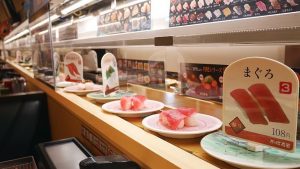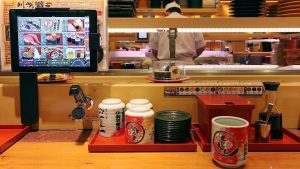 Kaitenzushi, or conveyor belt sushi, is a convenient, affordable and fun type of sushi restaurant characterized by the conveyor belt that winds through the restaurant. The conveyor belt carries plates of sushi past the diners, who can take whatever they wish. Each plate is color coded, and the color indicates the cost of that plate of sushi. Prices normally range between 100 Yen to 500 Yen. A description of the plates with their accompanying prices can be found on the menu or on signs placed around the restaurant. Kaitenzushi tend to be considerably cheaper than conventional sushi-ya., and can be found across the country. Seating is usually provided by counter seats along the conveyor belt, but many establishments also offer tables.
If you don’t see anything that looks good, you can make special orders. If the sushi chefs are located within the conveyor belt, you can ask the chef for your preferences. Or, larger kaitenzushi restaurants also have touch screen displays for ordering specific dishes which are delivered on a separate conveyor belt or by waiters.
Kaitenzushi, or conveyor belt sushi, is a convenient, affordable and fun type of sushi restaurant characterized by the conveyor belt that winds through the restaurant. The conveyor belt carries plates of sushi past the diners, who can take whatever they wish. Each plate is color coded, and the color indicates the cost of that plate of sushi. Prices normally range between 100 Yen to 500 Yen. A description of the plates with their accompanying prices can be found on the menu or on signs placed around the restaurant. Kaitenzushi tend to be considerably cheaper than conventional sushi-ya., and can be found across the country. Seating is usually provided by counter seats along the conveyor belt, but many establishments also offer tables.
If you don’t see anything that looks good, you can make special orders. If the sushi chefs are located within the conveyor belt, you can ask the chef for your preferences. Or, larger kaitenzushi restaurants also have touch screen displays for ordering specific dishes which are delivered on a separate conveyor belt or by waiters.
History of Kaitenzushi
Conveyor belt sushi was invented by Yoshiaki Shiraishi (1914–2001), who had problems staffing his small sushi restaurant and had difficulties managing the restaurant by himself. He got the idea of a conveyor belt sushi after watching beer bottles on a conveyor belt in an Asahi beer brewery. After five years of development, including the design of the conveyor belt and the speed of operations, Shiraishi opened the first conveyor belt sushi Mawaru Genroku Sushi in Higashi-Osaka, a suburb of Osaka, in 1958. A conveyor belt sushi boom started in 1970 after a conveyor belt sushi restaurant served sushi at the Osaka World Expo in 1970. Another boom started in 1980, when eating out became more popular, and finally in the late 1990s, when inexpensive restaurants became popular after the burst of the economic bubble.What to do at a Kaitenzushi restaurant
- Upon entering the restaurant, indicate whether you wish to sit at the counter or at a table (if applicable) and how many people are in your party.
 Condiments are usually found near the seats. For example, pickled ginger, chopsticks, soy sauce and small dishes for the soy sauce will be located on the counter near your seat. Wasabi may be either at the seat or on the conveyor belt. Self-serve tea is usually complimentary, with teacups usually found near the seat along with teabags or green tea powder in a storage container near the seats. There is also a hot water faucet to make tea. To make the tea, place some green tea powder (or tea bag) into the cup and add hot water from the dispenser.
Condiments are usually found near the seats. For example, pickled ginger, chopsticks, soy sauce and small dishes for the soy sauce will be located on the counter near your seat. Wasabi may be either at the seat or on the conveyor belt. Self-serve tea is usually complimentary, with teacups usually found near the seat along with teabags or green tea powder in a storage container near the seats. There is also a hot water faucet to make tea. To make the tea, place some green tea powder (or tea bag) into the cup and add hot water from the dispenser.- Once seated, you can start taking plates of food off the conveyor belt or order specific dishes directly from the sushi chef or server, or you can place orders electronically (if applicable).
- As you consume your sushi, stack the empty plates at your table. At the end of the meal, notify the server, and the server will calculate the bill based on the number and color of empty plates. You will then be handed your bill to be paid at the register near the exit. Some restaurants have a counting machine where the customer drops the plates to be counted automatically into a slot. You will either receive a receipt to give to the cashier. Or the total will be electronically sent to the cashier.
Etiquette
- Do not touch plates on the conveyor belt unless you intend to take them
- Do no put plates back onto the conveyor belt.





